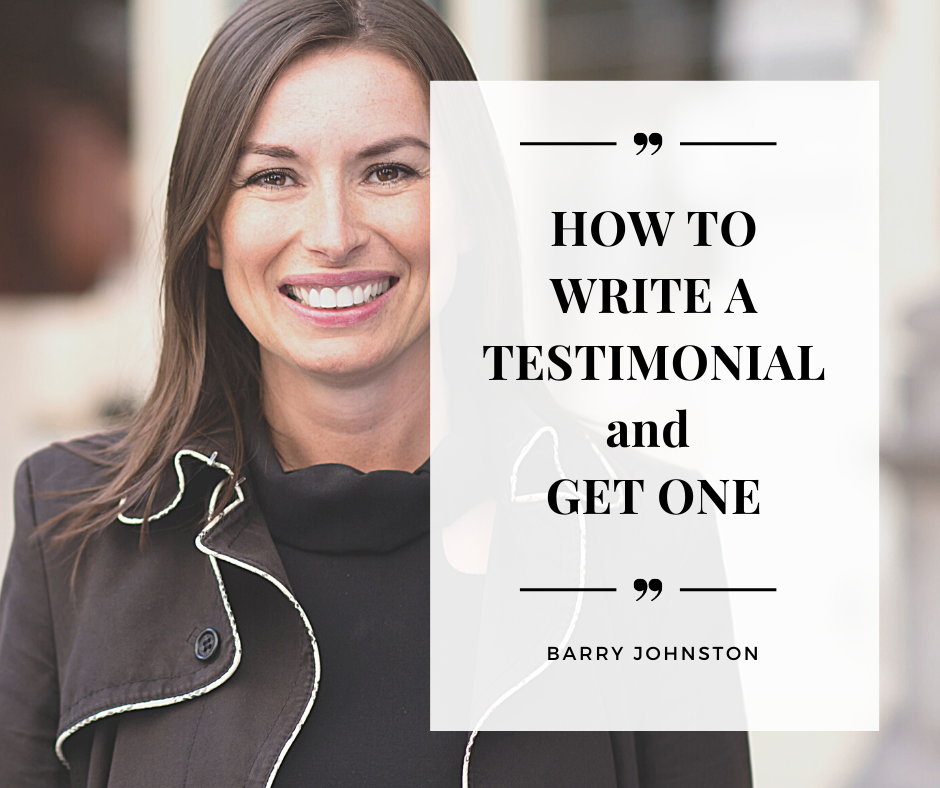The testimonial is an important component of developing and advancing one’s professional status. Knowing how to write one for others is not only a great way to help them advance their professional status, but it also says much about you as a supporter of their services.
In this article you will learn how to
- Write a testimonial for others
- Ask for a testimonial for yourself
The Authenticity Dilemma
Unfortunately, many organisations and individuals have fallen into the habit of creating bogus testimonials in the race to fast-track sales or build a profile that is nothing but a unicorn.
Companies and other employers are on to it, and if your testimonial is being used in a job application then the referee is going to be contacted! So, it is not a good idea to fudge testimonials! But what about online testimonials? You see them all the time, especially on websites and funnel advertising but who can tell what is real and what isn’t.
To ensure that a testimonial is truly “valid” the person writing the testimonial must be at least contactable. To do this a phone number or an email of the person writing the “testimony” should be present. I know what you are thinking! if I write a testimonial that will end up on a website, I don’t want every Tom, Dick and Harriet seeing my private contact details, and fair call! “Coach Check” have developed the first system of its kind where you can write a testimonial and keep your contact details confidential. Register your details with Coach Check and write your testimony for your favourite coach where it is submitted to them for approval.
How to write Testimonials
There are several kinds of testimonials
- Persuasive Testimonials. These demonstrate the impact the service had on the client or customer.
- Overcome Objections. These are testimonials that speak directly to common objections and diffuse them.
- Success Stories. These are miniature case studies where people share positive outcomes and happy endings.
Though they share the common goal of reducing resistance, each type of testimonial is most effective in different circumstances. Most testimonies should be brief and to the point, this will engage the reader to read it to the end, this does not mean that you cant write a longer more detailed testimony – especially if you are telling a story.
The best testimonials also contain these four elements:
Clarity. What is your relationship with the person?
Positivity. A testimonial is not critiquing someone— you need to be honest, but you want the overall tone to be optimistic.
Tell your story. Give the reader a clear picture of your success with the services.
Purposefulness. Guide the reader towards an action.
Focus. Do not ramble. Stay on point.
Examples of Testimonials with Good Structure
Testimonial 1.
I have the pleasure of being trained by Robert Hogan now for over six months. I am a client of his “Shape and Tone” program, which helped me to lose 25lbs of body fat and gain muscle in the right places. The training has totally changed my physical and mental well-being, of which I am eternally grateful. My friends simply cannot believe the results I have achieved, and my wife is over the moon!
I am a total fan of the services of Trainer Robert Hogan. I recommend Robert to anyone considering getting their lives back on track.
Testimonial 2.
This year I decided to enrol my 7-year-old child Julie into a martial arts program to help her gain more confidence! As an only child I felt she needed a little more than just going home every night after school.
My friends recommended Sensei Marie Jones from the Jones Karate Academy. Sensei Marie was so welcoming when I called in, I soon felt like one of the family and before any time at all my daughter Julie was a member of the Juniors program and enjoying her new group of friends, now she can’t wait to get to her classes every Tuesday and Thursday.
I highly recommend Sensei Marie Jones and her program to anyone considering the best children’s program out there!
Testimonial 3.
We have been using the services of Jane Ferguson at the Yourtown Senior High School for the delivery of Karate classes for the past 5 years.
Jane is the consummate professional, and we were able to take our students from white belt to orange belt in less than 3 months. Our students were so proud of their achievement and we have all the kids wanting to continue outside of the school curriculum. The most important aspect of Janes Karate classes is the respect learned and the way it has changed the overall demeanour of our students. We intend to continue the program into the future!
I recommend Jane Ferguson as a martial arts coach, mentor and professional.
TIPS
Be Specific with Details
Words and phrases like “always improving” and “it was good” are ambiguous and can mean anything.
Did you gain the results you were looking for, did you reach the 25lb’s of fat loss that you were looking for or did you achieve your martial arts goals faster by undertaking the training?
Do not be vague — if it’s so, say so. Testimonials with statistics are excellent social proof.
But keep in mind:
Statistics are not the only way to add details to a testimonial.
In fact, sometimes, you will be in situations where specific figures or numbers cannot be shared. In those instances, explain the details of the problem, concerns that existed beforehand, or share pertinent background info that paints a compelling before-and-after picture.
Consider these!
Let us compare two testimonials:
“Jane was pleasant to train with. I would certainly train with her again.”
That is nice, but does this testimonial really tell you anything? Not really. Compare it to this one:
“Jane is an awesome coach, not only did she keep me on track with goals, she made me accountable and never let me forget my promise to get back into shape. Because of her total commitment to helping me, I was able wear that suit that I have not fitted into for many years.
The details in this testimonial help you envision what it is like to work with Jane. A potential client thinking about hiring Jane does not have to guess how this other client benefited.
Make it heartfelt!
A heartfelt story can move even the most cold-hearted person.
There is a reason for this —people are wired to pay attention to narratives and stories. People just love stories! So, when telling a story tell it in a way that keeps them hanging on to find out how the story ends.
When a prospect in martial arts, sport or fitness relates to another customer’s testimonials, they take a step closer to working with that coach. They think, “wow, I have the same problem, maybe they can help me too” or “I am stuck in the same place, maybe working with this person will give me similar results.”
Be Authentic (But Do not be Boring)
It is easy to be dry, clinical, and cerebral — all the things you do not want your testimonial to be!
Boring testimonials will put prospects to sleep, and prospects who are asleep cannot act.
It’s not enough to simply not be boring. Your testimonial needs to be truthful and authentic too.
That means being genuine, sounding natural, and using conversational words. Your goal is to spark internal conversation within the reader. And to do that, every word in a testimonial must be true.
Remember, when someone reads a testimonial, you want them to relate, they should say, “Wow, he or she sounds just like me.”
How to Get Testimonials for yourself
The Art of the Ask
It is great to know how to write testimonials for others, but what about you? How do you build your list of testimonials to raise your own professional status and draw clients to the services that you offer?
Testimonials do not automatically come unless you ask for them or put a system in place to keep them rolling in.
We all get timid when it comes to asking for testimonials. We feel like they are being a nuisance. But when you deliver superb services to a client, this is a small ask.
Why not remove all friction points and make it easy for you and them?
Understand that even though your satisfied customers want to help, they are busy, and may be plagued by blank screen syndrome. You might write a sample testimonial and ask your client to revise it, it helps them to meet the point you wish to make on your profile.
How to Ask for a Testimonial
Consider the following script to request testimonials, this can be done via a variety of mediums including but not limited to, Face to face, Email, Social media! Try printing out a something to hand to your client, that way there is no confusion for them.
–Hi Bill,
I hope you are doing well.
I was wondering if you could help me by putting together a few brief words for me to put on my website.
I am looking for something like this,
“I began using the services of Jenny Brown to reduce a few kilo’s and gain back some muscle. 12 months on I have lost 20 kilo of fat and put on muscle in the right places. I am very happy with the results I have achieved.
If you are seeking similar result’s, then I highly recommend Jenny as your trainer.
Encourage them to include some of their own words if they wish, but this should give them the idea!
Do not underestimate the power of the testimonial!
Coach Check have created a powerful tool for all coaches wanting to expand their professional status.
Visit the link below! You may want to provide a testimonial for someone you know, but more importantly get yourself registered and start building your profile today.
Its FREE, no advanced qualifications required!
www.coachcheck.com



